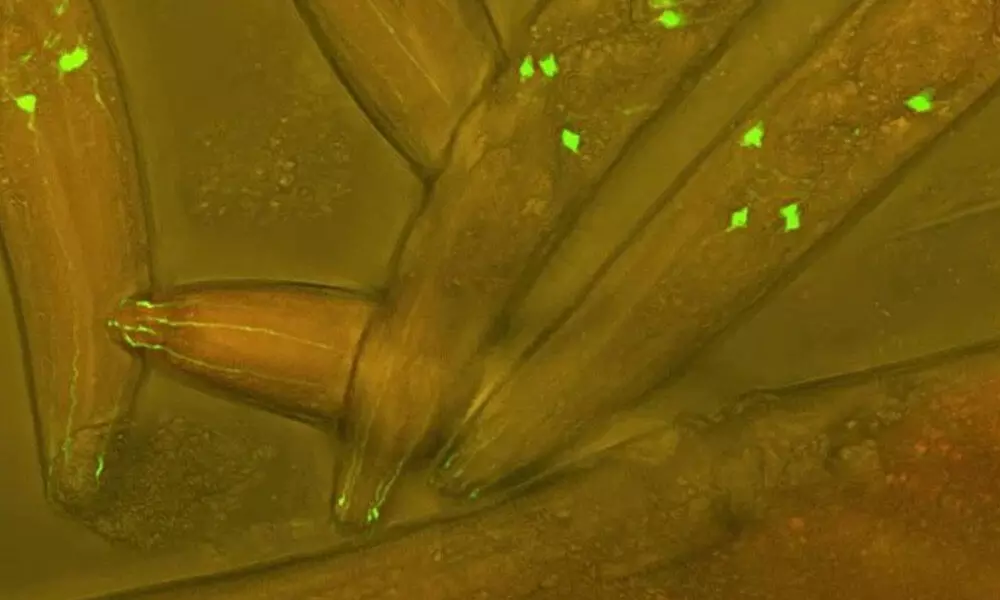Scientists Used Pieces From Hydra To Rearrange The Brain Of Mutant Worm

C. elegans with GFP-labelled nerves (Heiti Paves/Wikimedia Commons/CC BY-SA 3.0) (Photo/sciencealert)
- Scientists used parts from a Hydra to rewire the brain of a mutant worm.
- Synapses are the computer circuitry of the brain's logic gates, limiting certain signals while amplifying others and translating chemical fluctuations into something meaningful.
Scientists used parts from a Hydra to rewire the brain of a mutant worm. With their delicate wiring and gentle whispering of chemical information, brains aren't the easiest organs to study. Now that we've discovered that we can replace several essential chemical systems without the host animal knowing, this research could be made a little easier. The microscopic worm Caenorhabditis elegans was genetically handed bits of a nervous system obtained from a radically different creature, a fascinating freshwater organism known as Hydra, in a proof-of-concept study done by a team of US researchers.
It was similar to teaching a certain brain circuit a new language and discovering that it does its job just as well as before.
These small spaces are where a brain accomplishes the majority of its work. Synapses are the computer circuitry of the brain's logic gates, limiting certain signals while amplifying others and translating chemical fluctuations into something meaningful. By fiddling with this traffic-light system using a range of medications, genetic modifications, and light-operated switches, neuroscientists can learn a lot about how the nervous system works.
Turning things on and off and observing the resulting pandemonium can reveal a lot about how a neurological system works. After all, much of what we know about neuroscience has come from studying the effects of a damaged brain.
However, if you really want to understand how things work, you need to know if you can reconstruct or fix them after they've been broken. And that is extremely difficult to do Daniel Colón-Ramos of Yale University School of Medicine, the study's senior author, saysIn this example, the trick was to use components from another organism to 'repair' a faulty circuit in nematodes that ran on entirely different biochemical software.
Hydra aren't worms in the traditional sense. With tiny, tentacled bodies governed by a loosely connected spread of neurons arranged in a basic, net-like structure, they're more closely related to sea anemones.
Even stranger, the cells that make up this neural mesh interact with one another by squirting peptides into the hydra's body, where they activate matching receptors on other cells.
Hawk said that there are hundreds of neural peptides in Hydra, each of which could be a different channel of communication.
To test the concept, Hawk and his colleagues genetically altered specimens of C. elegans to lose their ability to feel full. These hungry worms exhibited foraging behaviors no matter how much food they'd consumed, giving the researchers a clear activity to watch for in their mutants.
From this group of worms they created two new lines one with the gene for a hydra neuropeptide, and another with the corresponding receptor gene.
Hawk and his colleagues genetically altered C. elegans specimens to make them lose their ability to feel full in order to test the theory. These hungry worms engaged in foraging activities regardless of how much food they had consumed, providing the researchers with a specific activity to look for in their mutants.
They generated two new lines from this group of worms, one with the gene for a hydra neuropeptide and the other with the gene for the matching receptor. The children of the two families joined the two sides of the nervous system to form a single nervous system. They had to rely on the hydra neuropeptides to signal the end of meal time because they didn't have their typical 'I'm full' brain circuit.
The successful swap is only the beginning. It's conceivable to separate the neurons that employ hydra neuropeptides to signal and have them communicate long distances thanks to the way they work.
HySyn, an unique messenger and receptor combination, could be only the beginning of a wide toolkit of replacement transmitters. HySyn, an unique messenger and receptor combination, could be only the beginning of a wide toolkit of replacement transmitters that researchers can utilise to comprehend the complexities of neuronal circuitry.
Next Story




















